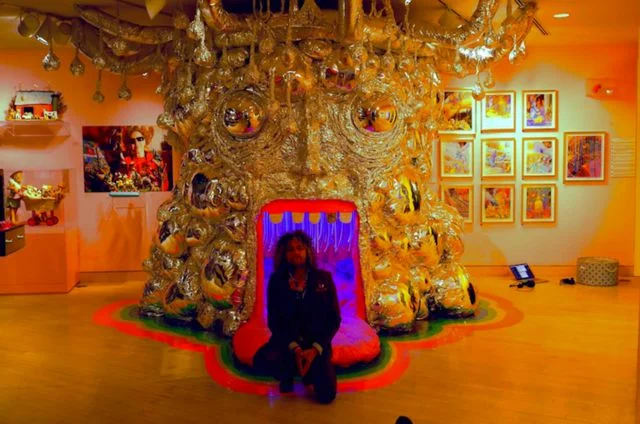King's Mouth: Wayne Coyne
Representation online is rapidly becoming an essential consideration for all forms of artistic expression. The ecosystem of art is evolving, and artists are becoming increasingly interdisciplinary by necessity and design. Rather than record sales, it is creative merchandise, unique live performances, and collaborations which afford musicians the ability to make music a career. Rihanna has a line of makeup, Ryan Trecartin has videos that can be viewed online and in galleries, Oprah may run for president, Tupac can still perform live as a hologram, and Laika has an exhibition at the Portland Art Museum. In order to preserve the autonomy of an idea, artists must contemplate art as experience, as well as consider the representation of that work across a variety of platforms.
As frontman for the Flaming Lips, Wayne Coyne is part musician, part creative director, and part object maker. The Flaming Lips are known for their elaborate stage setups, costumes, and unusual merchandise. Visuals are inextricable from their music and have been a part of the band’s presentation for many years.
A recurring theme in Coyne’s work is to create situations that include the audience/viewer in the experience. I attended a Flaming Lips show where he performed in a giant translucent bubble and invited many audience members to wear rubber alien masks and dance onstage while the band played. The experience felt more like an inclusive celebration than a performance.
This approach to creating situations is clearly evident in King’s Mouth, a multimedia installation and collection of drawings/paintings by Wayne Coyne, on view at PNCA’s 511 Gallery from November 2, 2017 through January 6, 2018. Entering the exhibition I was immediately face to face with a floor to ceiling reflective chrome head. Intriguing sounds and flickering lights emitted from inside the open mouth of the Moai-god-like structure, its bright pink tongue rolled out like a red carpet. I wanted to crawl across the tongue to see what was inside, however it was already crowded with people lying on their backs, so I decided to wait a moment for my turn to be eaten.
Meanwhile, I perused the 11 brightly colored drawings displayed on the walls of the gallery, each with an accompanying piece of text. Moving from piece to piece was like reading a beautifully illustrated graphic novel, with the writing style reminiscent of both children’s story books and song lyrics. The story details the life of a gargantuan magical king, from his birth, with universes and thunderstorms descending to become part of his head and mind, to his heroic death holding back an avalanche while saving the world’s last rainbow. Finally, the dead king’s tiny subjects cut off his head, carry it in a “mega funeral parade,” and dip the head in steel, its mouth preserved forever open.
The story is the quintessential hero’s journey with plenty of room left for interpretation. One key theme that resonated with me was the great power that exists in the meeting point between polarized emotional extremes. The funeral party is described as “happy” and “sad,” and the open mouth of the dead king is described as both “laughing” or “screaming”. It reminded me of the times in life where I have laugh-cried or cry-laughed. It is a state of collapsed duality where the parables of peaceful warriors and innocent wise people often find their meanings.
Equipped with the knowledge that I was crawling inside the head of the giant king to witness his vision of “outer space and all associated regions,” I returned to the central installation. After kicking off my shoes, crawling on all fours across the giant tongue, and passing through an archway of teeth, I arrived in the dark mouth chamber.
Lying in a circle of molars on a spongy tongue mattress, I found myself fully absorbed in many concentric strings of led lights flickering in patterns. At first there was a minimal and rapid pulsing of sound and lights which moved in unison like a groovy heart rate monitor. Suddenly beautiful choral sounds were layered on top of the ‘heartbeat,’ and the lights became more complex, flickering downward in raindrop-like formations. My dominant thought was that this was so rad! This was everything and nothing at the same time! I also found myself imagining angels as particulates in space and luminescent fairy dust showers.
After a short time absorbing the audio/visual stimulus, I noticed a large convex security mirror at the apex of the mouth chamber. The reflection of moving lights in the spherical mirror looked like the contracting and expanding ligaments of an iris. Hypnotized by the reflections in the mirror dancing like kaleidoscopic mandalas, I asked myself- “is this a mirror, an eye, a brain, sacred geometry, outer space, or all of the above? Is this what being born or dying is like?”
The interior of the installation creates a kind of synesthesia, where sound and light perform a unified choreography. The dead king’s visions bear signs and symbols of an alive thing which moves and makes sounds. Something magical and physiological happens. It’s like our biological hardware and software are being activated in order to synthesize the cogito argument with the lightning bolt that animated Dr.Frankenstein’s Adam.
The New York Times quoted Coyne as saying “I’m looking forward to the day when music is a liquid they pour into your head.” The installation portion of King’s Mouth is a being we encounter as alive in our minds. What happens inside the installation is an experience of combined light and sound, for which the viewer’s head must be present IRL. It is impossible to completely capture the experience in a photo or video.
The drawings and their accompanying pieces of writing detail the psychedelic backstory of the virtual king. The exhibition as a whole is held together by the fantastic fable, while the individual pieces are equally effective in fleshing out and animating the narrative. Each individual drawing looks like an album cover and is full of detail and texture. As a group the drawings are installed to be read from left to right like a comic book or film strip.
The installation is the animatronic soul of the king. An aspect of the exhibition that is a physical event you have to be there for, immune to digitization. Rather than virtual reality, this is a virtual being born of our perception. After all, what are humans but exquisite machines; woven, animated, and inspired by electromagnetic light?
For more information on PNCA's Center for Contemporary Art & Culture and the 511 Gallery, click here.
Image courtesy of PNCA's Center for Contemporary Art & Culture




